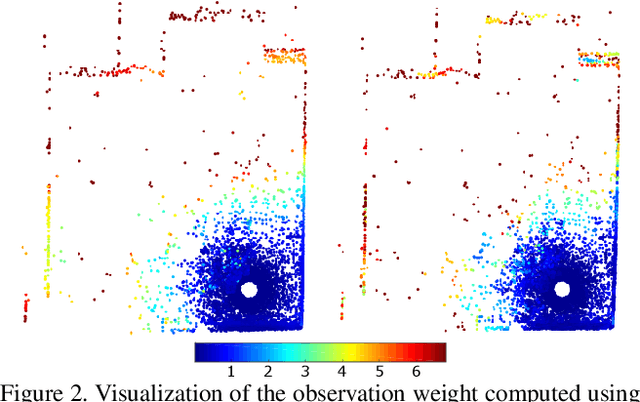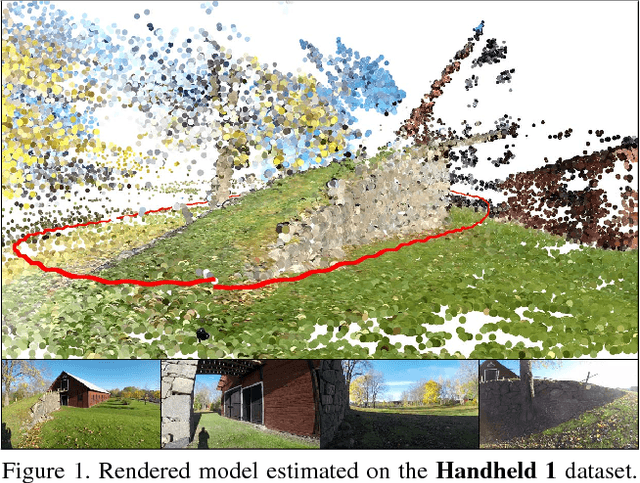Per-Erik Forssén
Continuous Normalizing Flows for Uncertainty-Aware Human Pose Estimation
May 04, 2025Abstract:Human Pose Estimation (HPE) is increasingly important for applications like virtual reality and motion analysis, yet current methods struggle with balancing accuracy, computational efficiency, and reliable uncertainty quantification (UQ). Traditional regression-based methods assume fixed distributions, which might lead to poor UQ. Heatmap-based methods effectively model the output distribution using likelihood heatmaps, however, they demand significant resources. To address this, we propose Continuous Flow Residual Estimation (CFRE), an integration of Continuous Normalizing Flows (CNFs) into regression-based models, which allows for dynamic distribution adaptation. Through extensive experiments, we show that CFRE leads to better accuracy and uncertainty quantification with retained computational efficiency on both 2D and 3D human pose estimation tasks.
FACT: Multinomial Misalignment Classification for Point Cloud Registration
Apr 09, 2025Abstract:We present FACT, a method for predicting alignment quality (i.e., registration error) of registered lidar point cloud pairs. This is useful e.g. for quality assurance of large, automatically registered 3D models. FACT extracts local features from a registered pair and processes them with a point transformer-based network to predict a misalignment class. We generalize prior work that study binary alignment classification of registration errors, by recasting it as multinomial misalignment classification. To achieve this, we introduce a custom regression-by-classification loss function that combines the cross-entropy and Wasserstein losses, and demonstrate that it outperforms both direct regression and prior binary classification. FACT successfully classifies point-cloud pairs registered with both the classical ICP and GeoTransformer, while other choices, such as standard point-cloud-quality metrics and registration residuals are shown to be poor choices for predicting misalignment. On a synthetically perturbed point-cloud task introduced by the CorAl method, we show that FACT achieves substantially better performance than CorAl. Finally, we demonstrate how FACT can assist experts in correcting misaligned point-cloud maps. Our code is available at https://github.com/LudvigDillen/FACT_for_PCMC.
Uncertainty Quantification Metrics for Deep Regression
May 07, 2024Abstract:When deploying deep neural networks on robots or other physical systems, the learned model should reliably quantify predictive uncertainty. A reliable uncertainty allows downstream modules to reason about the safety of its actions. In this work, we address metrics for evaluating such an uncertainty. Specifically, we focus on regression tasks, and investigate Area Under Sparsification Error (AUSE), Calibration Error, Spearman's Rank Correlation, and Negative Log-Likelihood (NLL). Using synthetic regression datasets, we look into how those metrics behave under four typical types of uncertainty, their stability regarding the size of the test set, and reveal their strengths and weaknesses. Our results indicate that Calibration Error is the most stable and interpretable metric, but AUSE and NLL also have their respective use cases. We discourage the usage of Spearman's Rank Correlation for evaluating uncertainties and recommend replacing it with AUSE.
GMSF: Global Matching Scene Flow
May 27, 2023Abstract:We tackle the task of scene flow estimation from point clouds. Given a source and a target point cloud, the objective is to estimate a translation from each point in the source point cloud to the target, resulting in a 3D motion vector field. Previous dominant scene flow estimation methods require complicated coarse-to-fine or recurrent architectures as a multi-stage refinement. In contrast, we propose a significantly simpler single-scale one-shot global matching to address the problem. Our key finding is that reliable feature similarity between point pairs is essential and sufficient to estimate accurate scene flow. To this end, we propose to decompose the feature extraction step via a hybrid local-global-cross transformer architecture which is crucial to accurate and robust feature representations. Extensive experiments show that GMSF sets a new state-of-the-art on multiple scene flow estimation benchmarks. On FlyingThings3D, with the presence of occlusion points, GMSF reduces the outlier percentage from the previous best performance of 27.4% to 11.7%. On KITTI Scene Flow, without any fine-tuning, our proposed method shows state-of-the-art performance.
Self-supervised learning of object pose estimation using keypoint prediction
Feb 19, 2023Abstract:This paper describes recent developments in object specific pose and shape prediction from single images. The main contribution is a new approach to camera pose prediction by self-supervised learning of keypoints corresponding to locations on a category specific deformable shape. We designed a network to generate a proxy ground-truth heatmap from a set of keypoints distributed all over the category-specific mean shape, where each is represented by a unique color on a labeled texture. The proxy ground-truth heatmap is used to train a deep keypoint prediction network, which can be used in online inference. The proposed approach to camera pose prediction show significant improvements when compared with state-of-the-art methods. Our approach to camera pose prediction is used to infer 3D objects from 2D image frames of video sequences online. To train the reconstruction model, it receives only a silhouette mask from a single frame of a video sequence in every training step and a category-specific mean object shape. We conducted experiments using three different datasets representing the bird category: the CUB [51] image dataset, YouTubeVos and the Davis video datasets. The network is trained on the CUB dataset and tested on all three datasets. The online experiments are demonstrated on YouTubeVos and Davis [56] video sequences using a network trained on the CUB training set.
Camera Calibration without Camera Access -- A Robust Validation Technique for Extended PnP Methods
Feb 14, 2023Abstract:A challenge in image based metrology and forensics is intrinsic camera calibration when the used camera is unavailable. The unavailability raises two questions. The first question is how to find the projection model that describes the camera, and the second is to detect incorrect models. In this work, we use off-the-shelf extended PnP-methods to find the model from 2D-3D correspondences, and propose a method for model validation. The most common strategy for evaluating a projection model is comparing different models' residual variances - however, this naive strategy cannot distinguish whether the projection model is potentially underfitted or overfitted. To this end, we model the residual errors for each correspondence, individually scale all residuals using a predicted variance and test if the new residuals are drawn from a standard normal distribution. We demonstrate the effectiveness of our proposed validation in experiments on synthetic data, simulating 2D detection and Lidar measurements. Additionally, we provide experiments using data from an actual scene and compare non-camera access and camera access calibrations. Last, we use our method to validate annotations in MegaDepth.
Registration Loss Learning for Deep Probabilistic Point Set Registration
Nov 04, 2020



Abstract:Probabilistic methods for point set registration have interesting theoretical properties, such as linear complexity in the number of used points, and they easily generalize to joint registration of multiple point sets. In this work, we improve their recognition performance to match state of the art. This is done by incorporating learned features, by adding a von Mises-Fisher feature model in each mixture component, and by using learned attention weights. We learn these jointly using a registration loss learning strategy (RLL) that directly uses the registration error as a loss, by back-propagating through the registration iterations. This is possible as the probabilistic registration is fully differentiable, and the result is a learning framework that is truly end-to-end. We perform extensive experiments on the 3DMatch and Kitti datasets. The experiments demonstrate that our approach benefits significantly from the integration of the learned features and our learning strategy, outperforming the state-of-the-art on Kitti. Code is available at https://github.com/felja633/RLLReg.
Density Adaptive Point Set Registration
Oct 23, 2018



Abstract:Probabilistic methods for point set registration have demonstrated competitive results in recent years. These techniques estimate a probability distribution model of the point clouds. While such a representation has shown promise, it is highly sensitive to variations in the density of 3D points. This fundamental problem is primarily caused by changes in the sensor location across point sets. We revisit the foundations of the probabilistic registration paradigm. Contrary to previous works, we model the underlying structure of the scene as a latent probability distribution, and thereby induce invariance to point set density changes. Both the probabilistic model of the scene and the registration parameters are inferred by minimizing the Kullback-Leibler divergence in an Expectation Maximization based framework. Our density-adaptive registration successfully handles severe density variations commonly encountered in terrestrial Lidar applications. We perform extensive experiments on several challenging real-world Lidar datasets. The results demonstrate that our approach outperforms state-of-the-art probabilistic methods for multi-view registration, without the need of re-sampling. Code is available at https://github.com/felja633/DARE.
* CVPR 2018 (Oral)
Trajectory Representation and Landmark Projection for Continuous-Time Structure from Motion
May 07, 2018



Abstract:This paper revisits the problem of continuous-time structure from motion, and introduces a number of extensions that improve convergence and efficiency. The formulation with a $\mathcal{C}^2$-continuous spline for the trajectory naturally incorporates inertial measurements, as derivatives of the sought trajectory. We analyse the behaviour of split interpolation on $\mathbb{SO}(3)$ and on $\mathbb{R}^3$, and a joint interpolation on $\mathbb{SE}(3)$, and show that the latter implicitly couples the direction of translation and rotation. Such an assumption can make good sense for a camera mounted on a robot arm, but not for hand-held or body-mounted cameras. Our experiments show that split interpolation on $\mathbb{SO}(3)$ and on $\mathbb{R}^3$ is preferable over $\mathbb{SE}(3)$ interpolation in all tested cases. Finally, we investigate the problem of landmark reprojection on rolling shutter cameras, and show that the tested reprojection methods give similar quality, while their computational load varies by a factor of 2.
Spline Error Weighting for Robust Visual-Inertial Fusion
Apr 13, 2018



Abstract:In this paper we derive and test a probability-based weighting that can balance residuals of different types in spline fitting. In contrast to previous formulations, the proposed spline error weighting scheme also incorporates a prediction of the approximation error of the spline fit. We demonstrate the effectiveness of the prediction in a synthetic experiment, and apply it to visual-inertial fusion on rolling shutter cameras. This results in a method that can estimate 3D structure with metric scale on generic first-person videos. We also propose a quality measure for spline fitting, that can be used to automatically select the knot spacing. Experiments verify that the obtained trajectory quality corresponds well with the requested quality. Finally, by linearly scaling the weights, we show that the proposed spline error weighting minimizes the estimation errors on real sequences, in terms of scale and end-point errors.
 Add to Chrome
Add to Chrome Add to Firefox
Add to Firefox Add to Edge
Add to Edge